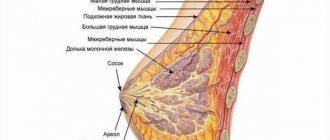When does breast growth start and stop?
During puberty, changes begin to occur in a girl’s body and body:
- Your period begins.
- The menstrual cycle is established.
- Weight changes.
- Changes occur in the psycho-emotional state.
- Breasts begin to grow.
Not everyone perceives all these changes with delight. Girls begin to compare themselves with friends and peers and look for shortcomings in themselves. What causes the most complexes is the way the breasts grow. Some don't like that it's too big, others worry about the small size.
This is a very difficult period for every girl. I am constantly haunted by a feeling of self-doubt; my own body seems unattractive. Many people develop an “ugly duckling” complex.
Puberty lasts differently for everyone. The hormonal balance in the body is established at different times for everyone. One can only judge accurately the beginning of this period: the first menstruation appears and the breasts begin to grow.
To what age and size the mammary glands increase, no specialist can say for sure. This process usually lasts several years. In most cases, you can find out when breast growth stops by adding two years to the beginning of your first menstruation.
Breast growth during pregnancy

The gland begins to grow and prepares to produce an important product for feeding a newborn - mother's milk. Therefore, it is very important to properly care for her throughout pregnancy, which will ensure its development and reduce the occurrence of side effects (stretch marks, prolapse, unpleasant pain).
Start of growth
As soon as the fertilized egg attaches to the walls of the uterus, changes begin to occur in the body, including in the mammary gland. It is difficult to say exactly when there is obvious breast enlargement, since this happens differently for each woman. In some, the beginning of active development is observed at 4 weeks, while in others, breast growth occurs in the third month of gestation. But breasts grow in the first trimester in all women expecting a child.
No matter what time this happens, almost everyone feels aching sensations in the mammary gland and heaviness in it.
What causes the mammary gland to change?
When milk appears after the birth of a child, a woman’s breasts undergo significant changes.
This is influenced by the following hormones:
- progesterone;
- estrogen.
They are produced in large quantities after pregnancy in the pituitary gland and begin to form milk ducts and glandular tissue.
A woman's breasts are made up of 20 lobes, which have milk ducts leading into the nipples. During an increase in progesterone and estrogen in the blood of a pregnant woman, the lobes increase in volume due to the proliferation of cells responsible for milk production.
It is their increase and the formation of hormones in the body that provoke the feeling of a denser state of the mammary gland. It increases in volume. During the entire period of gestation, it grows by one or two sizes.
At 12–14 weeks, colostrum is formed in the mammary gland, which can gradually be released from the breast and is characterized by a yellowish tint. And in the last month of pregnancy, the breasts take on their final shape and are completely ready to feed a newborn.
The main month in which breast enlargement occurs is the third and eighth. It is at this time that the woman notices that her breasts have visually increased. But she will grow and develop throughout the entire period of bearing the child.
What affects breast size?
When the bust begins to increase, girls closely monitor this process. Unfortunately, it is not possible to guess the exact size; this can only be assumed.
Pregnancy and lactation also make their own adjustments to bust size.
Don't think that the only thing that matters is when your breasts start and stop growing. Changes occur throughout life, but they are difficult to notice with the naked eye.
The age to which the bust will grow is influenced by several factors:
- Heredity. If your closest relatives have small breasts, then you can only dream of curvy figures.
- Build. A small amount of subcutaneous fat will not benefit the size. Under such conditions, breasts are unlikely to grow to size 3 or larger. Therefore, slender and fragile women most often have a small bust. In addition, if a thin girl’s breasts begin to grow to an exorbitant size, it is necessary to consult a doctor, as this indicates hormonal disorders.
- The area in which the girl grew up also plays an important role. According to research, residents of the south and east mature much earlier than Europeans. You can often notice that village residents have lush and firm breasts. This is facilitated by fresh air, a measured pace of life, and natural products.
- When breasts begin to grow, much attention should be paid to estrogens. These hormones have a direct impact on the formation of the female body. Lack of estrogen can negatively affect bust size.
- Incorrect posture and lack of physical activity have a negative impact on the development of the female body. In adolescence, you need to watch your posture and not slouch, as this can compress the chest and slow down the growth of the mammary glands.
- The quality of nutrition has an indirect relationship to the growth of female breasts. A lack of nutrients necessary for the body can lead to defective development of the entire body. Some people think that when breasts begin to grow, you need to eat more. After all, plump women always have larger busts. But this is a mistaken opinion. Extra pounds can go completely wrong where you would like, and will greatly spoil your appearance.
- The shape of the bust is influenced by the bra. It is designed to support this part of the body and is where it spends most of its time. Therefore, the bra should be quite tight, not too tight, because this can interfere with blood circulation and lead to cramping, but not loose.
Symptoms of enlargement
Changes in the mammary glands when carrying a baby appear starting from the second month. Not only will the breasts grow, but their sensitivity will also increase, and some women will experience pain and itching.
The main signs of breast growth during pregnancy and its preparation for feeding include the following:
- Blueish veins appear on the skin of the chest. They appear due to an increase in glandular tissue.
- Changes in the nipples. At 20 weeks of pregnancy, there comes a time when the nipple is formed and modified. It not only darkens, but also increases in size.
- The appearance of stretch marks. This does not happen to all women and depends on the elasticity of the skin. With a sharp increase in breast size, the connective tissue fibers burst and red stripes form, which turn white after a few months.
- A good indicator of proper breast development during pregnancy is the release of colostrum starting at 6 months. Its composition is much thicker than that of breast milk. If the discharge is heavy, doctors recommend purchasing special bra pads at the pharmacy. But there is no need to express it. This release of colostrum is accompanied by itching in the nipple area and areola. This is normal.
Women believe that there is some connection between the time of appearance of colostrum and the amount of milk produced after childbirth. In fact, mammologists do not combine these two concepts. Just like there is no connection between breast size and the amount of breast milk.
All these are clear indicators of the development of the mammary glands and their preparation for feeding a newborn.
The influence of hormonal levels
Women's breasts are exposed to various hormones throughout their lives. Moreover, there is a strictly balanced set of specific components responsible for this part of the body.
In particular, three hormones are responsible for the shape and size of the mammary glands:
- Estrogen.
- Progesterone.
- Prolactin.
These substances affect the body of women from the beginning of the menstrual cycle until menopause. They are secreted by the ovaries and adrenal glands.
According to experts, the main influence on the beauty and health of a woman’s breasts is the regularity and speed of formation of the menstrual cycle. Every month before ovulation, changes occur in the body that lead to engorgement and swelling of the breasts and increased sensitivity.
Unfortunately, after menstruation ends, the breasts return to their previous state.
This previous state is directly related to the final establishment of the menstrual cycle, after which the bust stops growing. But even then it cannot be said that the process of breast formation is complete.
The mammary glands can reach their largest size during pregnancy and lactation, which again occurs under the influence of hormones. Many experts argue that nulliparous women have underdeveloped breasts.
Therefore, normal hormonal balance is very important. This is the main factor by which one can judge at what age a woman’s breasts will grow. Girls who are unhappy with their breasts and consider this to be a consequence of hormonal imbalance should consult a doctor.
After a series of tests, he will prescribe appropriate treatment. In this case, it is not advisable to correct the situation yourself. This can have serious consequences for the entire body.
Caring for growing breasts during pregnancy
In order for the mammary gland to develop normally during pregnancy, a woman needs to properly care for it. When the breast increases in size several times, it is very important to choose the right size of underwear, since any compression by a bra increases the possibility of inflammatory processes in the mammary gland.
In addition to the appropriate size, underwear performs a number of the following functions:
- evenly distribute the load that occurs during breast growth;
- keep your breasts toned;
- minimize the possibility of stretch marks on the skin.
When breasts begin to grow during pregnancy, choose a bra made from natural fabrics with a front clasp. The second indicator is not so significant and mandatory. But it will be easier for a pregnant woman to wear a bra that fastens in the front. The model of the bra suitable for this period is characterized by wide straps, which guarantees load distribution and reduces pain in the thoracic spine.
Doctors recommend that women with large breasts sleep in a special bra at night. This guarantees her support.
Preparing the mammary gland during pregnancy includes proper cleansing. It must be done at least twice daily. The chest is washed with warm water and soap. After the cleansing procedure, the skin and nipples are lubricated with a rich cream, which protects the gland from the development of stretch marks and cracks on the surface of the areola. The product for treating breast skin contains silicone and vitamin E. Start using this cream from the second month of pregnancy. It is worth noting that stretch marks that have already appeared cannot be removed with such means, but the appearance of new ones can be prevented.
For hygiene procedures, it is recommended to use a contrast shower for the mammary gland. It helps maintain the elasticity and shape of the breast during its growth.
But adhere to important rules:
- the temperature difference is not large;
- the procedure lasts no more than 5 minutes.
Do not use a contrast shower when the sensitivity of the breast is very increased or the procedure itself causes discomfort.
Transformation from girl to woman
At an early age, girls' breasts are no different from boys' breasts. The first changes begin to occur between the ages of 8 and 10 years. The amount of estrogen in the body begins to increase, which is why the breast tissue begins to gradually increase. It is the growth of the areola and nipple that characterizes the beginning of a girl’s puberty and the growth of her breasts. The color of the areola can be influenced by a number of factors, such as race and skin color. The nipple area is characterized by a pale pink color with a slight tint of brown. Girls should not panic if their areolas suddenly darken. There is nothing dangerous in this, since changes in color are characterized by the individual characteristics of the female body. Then, tubercles resembling small bumps begin to appear in the areola area. These glands are responsible for secreting sebum, which acts as a lubricant for the skin. Thanks to its presence, the skin around the nipple is always moisturized and does not crack.










